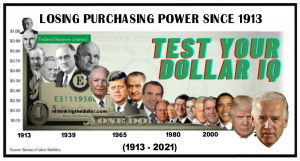It all seems so systematic, arranged, and orderly. Almost a direct proof of deism.
Sixty seconds make a minute, 60 minutes make an hour, 24 hours make a day, and one day equals one complete rotation of the planet earth.
Roughly every 30 days the moon orbits the earth – which is one month. Then every 12 months the earth orbits the sun – which is one year.
So far so good, right?
But here’s where the nice and neat order of it all breaks down. Because if you try to measure one of earth’s orbits of the sun in days it’s not so divinely tidy. For it takes 365 days plus an inconvenient 6 hours to fully complete the cycle.
But we don’t let these inconvenient 6 hours hamper our perfection. We’re humans, after all. We innovate, invent, and make the world in our image. So when the numbers don’t jive, we do what must be done. We fudge them.
We create an off balance account. We concoct modern monetary theory. We contrive negative interest rate policy. And we invent leap year.
Tomorrow [Saturday] is the day the books must be reckoned. Peering into our off balance account we find 24 accrued hours that must be tallied up and written off.
Consequently, we must have a day of reckoning for the disorder of the last four years. We must resynchronize the calendar year with the astronomical year. Moreover, we must reground our measuring system with its baseline – its reference point.
Without this resynchronization, what’s a year really measuring?
Perhaps, the calendar wouldn’t get too off kilter for a decade or two. But in just 28-years the calendar would be off by an entire week. Not long after that, the calendar would be debased to nothing more than etched lines inside a cave dwellers grotto. Pointless and meaningless abstractions.
“A Technology, Called a Printing Press”
So goes the dollar – or any paper money – when it’s not backed by gold or some other commodity that can’t be created at will. For without a stable base to hold its supply in check, what’s a dollar anyway?
It’s abstract, indefinite, and arbitrary. It can be created out of thin air at the whims of the Federal Reserve. A pocket full of dollars one day and you can buy the things you want and need. On the next day these same dollars can revert to their intrinsic value – at par with bird cage liner.
Dollar convertibility to gold once limited U.S. Treasury budgets and the Federal Reserve’s credit creation machine. But that was before Nixon severed the dollar’s link to gold and commenced the dollar reserve standard. Prior to 1971, a foreign bank could exchange $35 with the U.S. Treasury for an ounce of gold. After that, when foreign banks handed the U.S. Treasury $35, they received $35 in exchange.
At the G-10 Rome meeting held in late-1971, Treasury Secretary John Connally reduced the new dollar reserve standard to a bite-sized nugget for his European finance minister counterparts:
“The dollar is our currency, but it’s your problem.”
Unlike gold, which has no debt obligation or counterparty risk, dollars can expire worthless when their promissory obligation is defaulted on. Alternatively, they can be inflated to nothing when a desperate Fed cranks up the printing press, and begins helicopter dropping suitcases of money over major urban centers.
If this helicopter drop concept is new to you let us assure you that it is no joke. In fact, this is what former Federal Reserve Chairman, B.S. Bernanke, said the Fed would do in a time of financial crisis. He laid it out very clearly in his November 21, 2002 speech, Deflation: Making Sure “It” Doesn’t Happen Here.
Then, as Federal Reserve Governor, Bernanke provided the following clarification…
“The U.S. Government has a technology, called a printing press (or, today, its electronic equivalent), that allows it to produce as many U.S. dollars as it wishes at essentially no cost. By increasing the number of U.S. dollars in circulation, or even by credibly threatening to do so, the U.S. Government can also reduce the value of a dollar in terms of goods and services, which is equivalent to raising the price in dollars of those goods and services.”
Later in this same speech, Bernanke made reference to a “helicopter drop,” alluding to a central banker hovering in a helicopter and dropping suitcases full of money to William Jennings Bryan’s “struggling masses” below.
But even if the dollar isn’t worthless – yet – its continual variability is a continual problem. How does one save and invest when the dollar’s monetary base is continuously inflated?
Where Did Your Money Go?
When a carpenter measures the length of a cabinet as being 3 feet, he’s certain that the length measured as 3 feet will always be 3 feet. No more. No less.
To the contrary, when a saver squirrels away $1, he has no assurance that the value of that dollar will be preserved. For example, using the Bureau of Labor Statistics’ own CPI inflation calculator, $1 in 2020 has the same purchasing power that $0.15 had 1971 – the year the dollar’s last tie with gold was severed. Where did the other $0.85 go?
In all truth, it was covertly stolen from savers and redistributed by the government. This, no doubt, is a national disgrace.
Over several decades, the baseline – the dollar – used to measure the value of goods and services has been twisted and contorted like a politician’s spine. The quantity of dollars in existence has increased. Accordingly, the unit value of the dollar has decreased.
To be clear, prices of individual goods and services will fluctuate to account for natural changes in supply and demand. But when money is anchored to a stable reference point, like during the classical gold standard of the 19th century, overall prices will by and large be stable.
With respect to recording the passage of time, leap year’s necessary, vital, and appropriate, for preserving the calendar year’s conformity with its baseline. So, too, today’s money needs a stable base to derive its meaning and value from.
Without such a reference point, we’ll just continue to spin out of orbit. Money will continue to accrue more zeros at the end of everything it measures. Yet, what good’s a $100 dollar bill if it only buys you what a $1 dollar bill did before?
So enjoy your day of reckoning. The time was there all along…it just needed to be reconciled. Alas, we have a startling suspicion that reckoning the distortions of the dollar reserve standard will not be so amiable. Though it’s necessary, all the same.
Article written by MN Gordon for EconomicPrism.com

RTD 1oz. Round
RTD 5oz. Round










0 Comments